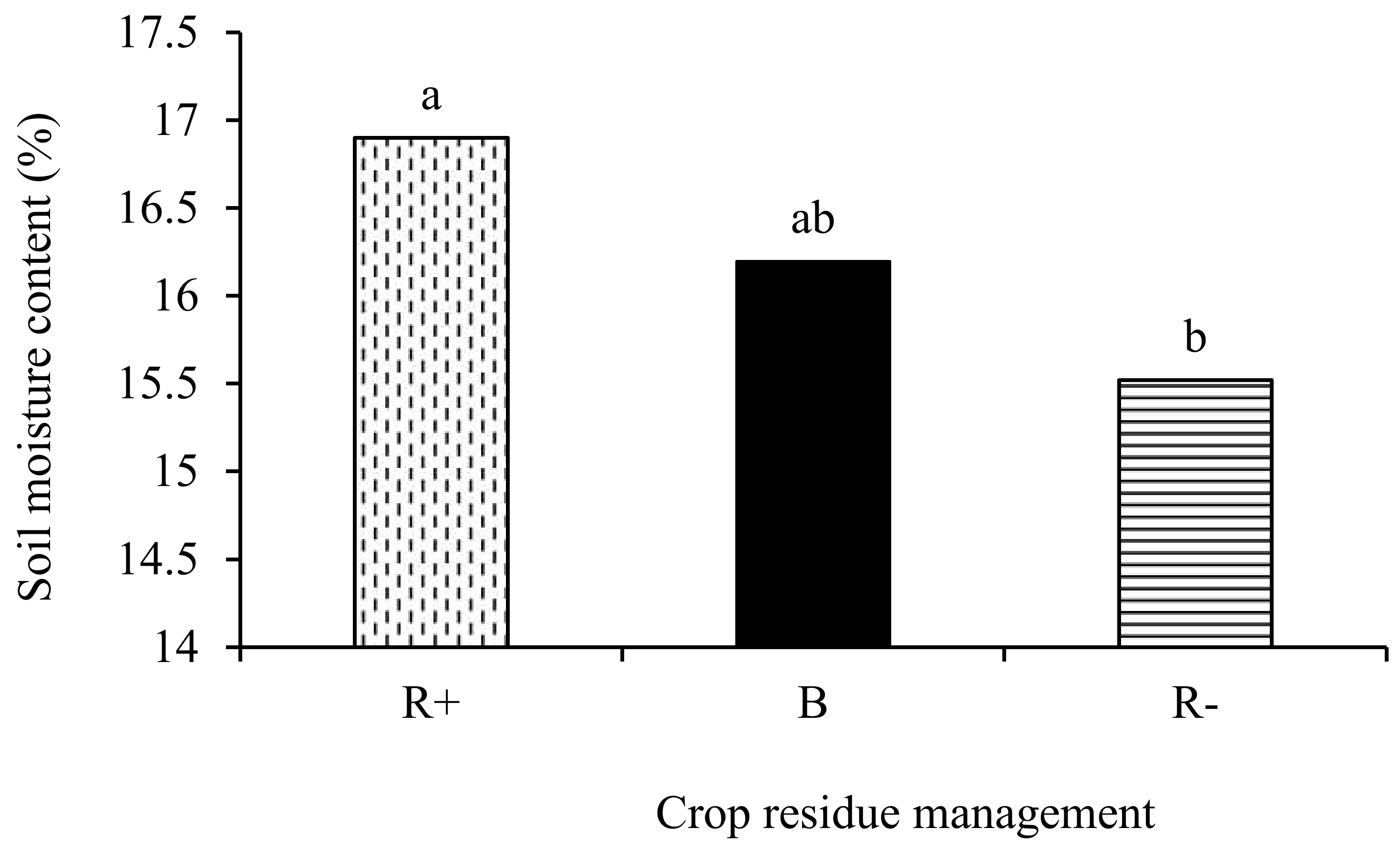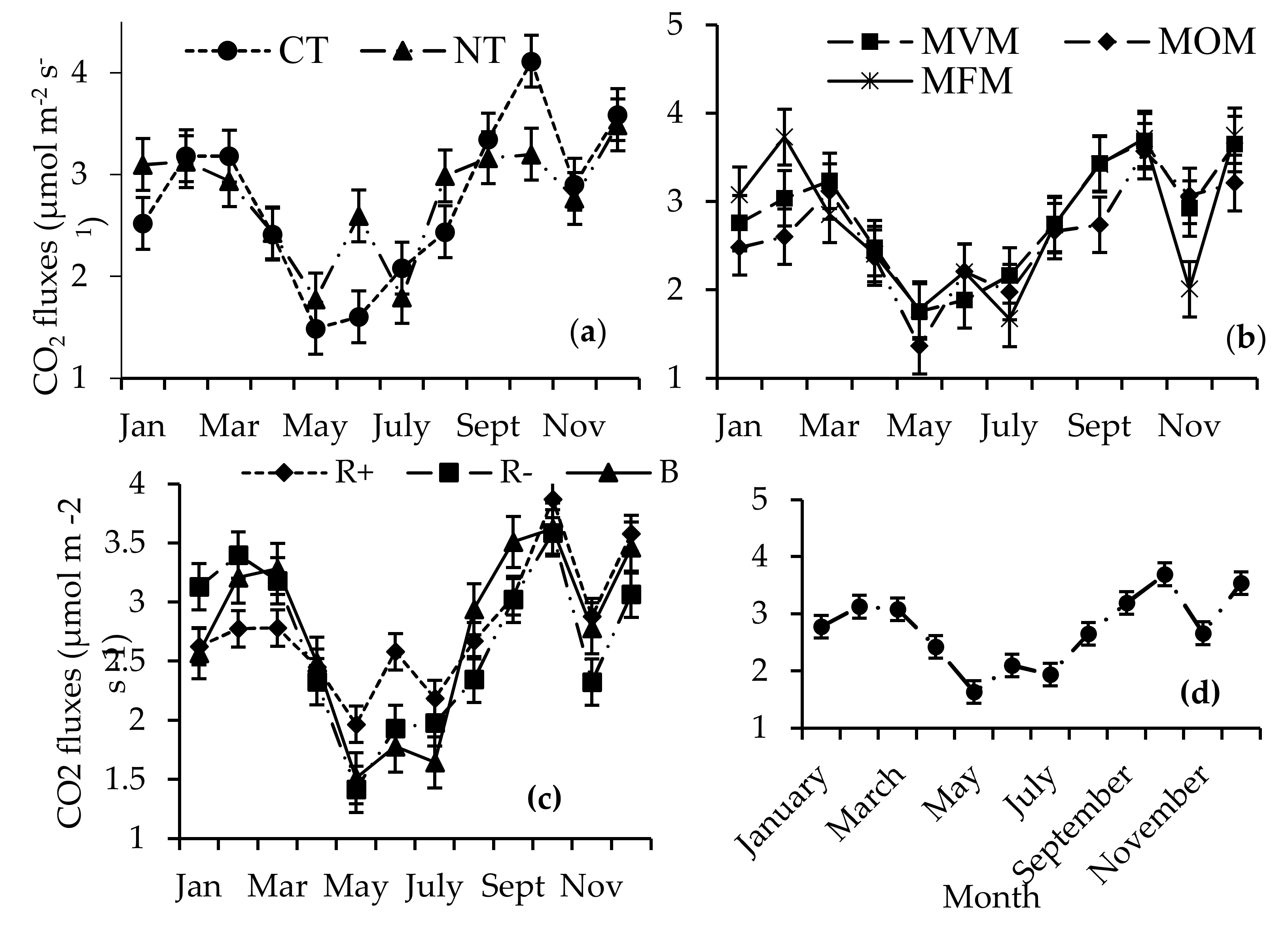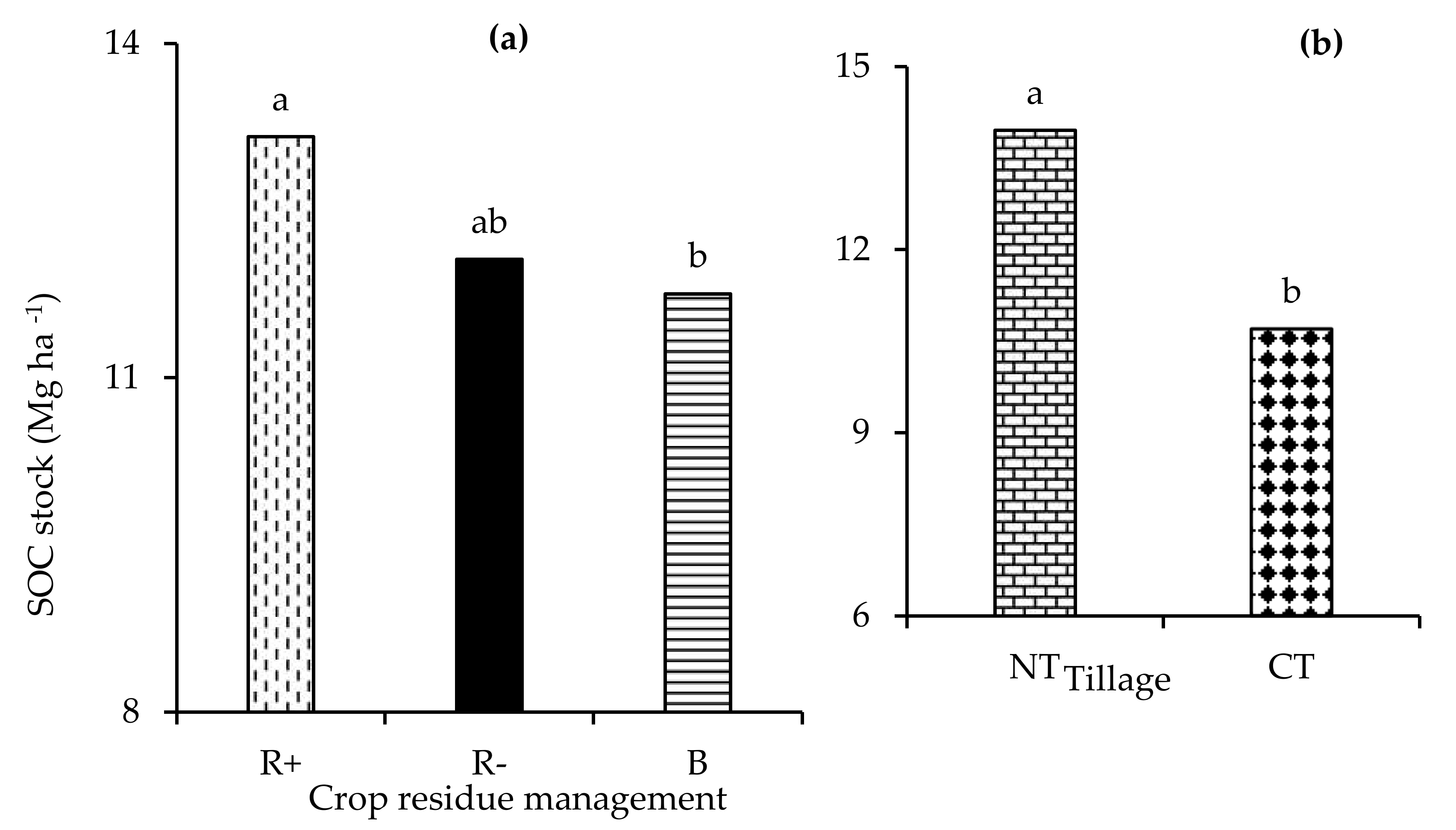Carbon Dioxide Fluxes and Carbon Stocks under Conservation Agricultural Practices in South Africa
Abstract
:1. Introduction
2. Materials and Methods
2.1. Site Selection
2.2. Daily Rainfall and Air Temperature
2.3. Treatments and Experimental Design
2.4. Management of Non-Experimental Variables
2.5. Soil Sampling and Analysis
2.6. Carbon Stocks
2.7. Carbon Dioxide Fluxes, Soil Temperature and Moisture
2.8. Statistical Analysis
3. Results
3.1. Soil Temperature and Moisture Content
3.2. Carbon Dioxide Fluxes
3.3. Carbon Stocks
4. Discussion
4.1. Soil Temperature and Moisture Content
4.2. Carbon Dioxide Fluxes
4.3. Carbon Stocks
5. Conclusions
Author Contributions
Funding
Conflicts of Interest
References
- Li, X.; Liu, L.; Yang, H.; Li, Y. Relationships between carbon fluxes and environmental factors in a drip-irrigated, film-mulched cotton field in arid region. PLoS ONE 2018, 13. [Google Scholar] [CrossRef] [PubMed] [Green Version]
- Stats, S.A. Millennium Development Goals Country Report; Statistics SA: Pretoria, South Africa, 2013. [Google Scholar]
- Greenhouse Gas Inventory South Africa, 2009 Greenhouse Gas Inventory South Africa; National Inventory Report 1990–2000; Department of Environmental Affairs and Tourism: Pretoria, South Africa, 2009.
- Christian, T.; Wall, P.C. Effects of conservation agriculture techniques on infiltration and soil water content in Zambia and Zimbabwe. Soil Tillage Res. 2009, 105, 217–227. [Google Scholar]
- The Intergovernmental Panel on Climate Change (IPCC). Summary for Policymakers. Climate Change 2014 Impacts, Adaptation, and Vulnerability. Part A: Global and Sectoral Aspects; Working Group II Contribution to the Fifth Assessment Report of the Intergovernmental Panel on Climate Change; Cambridge University Press: Cambridge, UK; New York, NY, USA, 2014. [Google Scholar]
- Dyer, L.A.; Richards, L.A.; Short, S.A.; Dodson, C.D. Effects of CO2 and temperature on tritrophic interactions. PLoS ONE 2013, 8, e62528. [Google Scholar] [CrossRef] [PubMed]
- Hernandez-Ramirez, G.; Hatfield, J.L.; Parkin, T.B.; Sauer, T.J.; Prueger, J.H. Carbon dioxide fluxes in corn–soybean rotation in the Midwestern U.S.: Inter- and intra-annual variations, and biophysical controls. Publications from USDA-ARS/UNL Faculty. Agric. For. Meteorol. 2011. [Google Scholar] [CrossRef] [Green Version]
- Cheesman, S.; Thierfelder, C.; Eash, N.S.; Kassie, G.T.; Frossard, E. Soil carbon stocks in conservation agriculture systems of Southern Africa. Soil Tillage Res. 2016, 156, 99–109. [Google Scholar] [CrossRef]
- Nyambo, P.; Chiduza, C.; Araya, T. Carbon input and maize productivity as influenced by tillage, crop rotation, residue management and biochar in a semiarid region in South Africa. Agronomy 2020, 10, 705. [Google Scholar] [CrossRef]
- Rockström, J. On-Farm Agrohydrological Analysis of the Sahelian Yield Crisis: Rainfall Partitioning, Soil Nutrients and Water Use Efficiency of Pearl Millet. Ph.D. Thesis, Stockholms Universitet, Stockholm, Sweden, 1997. [Google Scholar]
- Hobbs, P.R.; Sayre, K.; Gupta, R. The role of conservation agriculture in sustainable agriculture. Philos. Trans. R. Soc. B Biol. Sci. 2008, 363, 543–555. [Google Scholar] [CrossRef]
- Delgado, A.J.; Groffman, P.M.; Nearing, M.A.; Goddard, T.; Reicosky, D.; Lal, R.; Kitchen, N.R.; Rice, C.W.; Towery, D.; Salon, P. Conservation practices to mitigate and adapt to climate change. J. Soil Water Conserv. 2011, 66, 118A–129A. [Google Scholar] [CrossRef] [Green Version]
- Morell, F.J.; Cantero-Martínez, C.; Lampurlanés, J.; Plaza-Bonilla, D.; Álvaro-Fuentes, J. Soil carbon dioxide flux and organic carbon content: Effects of tillage and nitrogen fertilization. Soil Sci. Soc. Am. J. 2011, 75, 1874–1884. [Google Scholar] [CrossRef]
- Lal, R.; Bruce, J.P. The potential of world cropland soils to sequester C and mitigate the greenhouse effect. Environ. Sci. Policy 1999, 2, 177–185. [Google Scholar] [CrossRef]
- Stockle, C.; Higgins, S.; Kemanian, A.; Nelson, R.; Huggins, D.; Marcos, J.; Collins, H. Carbon storage and nitrous oxide emissions of cropping systems in Eastern Washington: A simulation study. J. Soil Water Conserv. 2012, 67, 365–377. [Google Scholar] [CrossRef] [Green Version]
- Zuber, S.M.; Behnke, G.D.; Nafziger, E.D.; Villamil, M.B. Carbon and nitrogen content of soil organic matter and microbial biomass under long-term crop rotation and tillage in Illinois, USA. Agriculture 2018, 8, 37. [Google Scholar] [CrossRef] [Green Version]
- Campbell, B.; Chen, L.; Dygert, C.; Dick, W. Tillage and crop rotation impacts on greenhouse gas fluxes from soil at two long-term agronomic experimental sites in Ohio. J. Soil Water Conserv. 2014, 69, 543–552. [Google Scholar] [CrossRef] [Green Version]
- Cambardella, C.A.; Elliott, E.T. Particulate soil organic-matter changes across a grassland cultivation sequence. Soil Sci. Soc. Am. J. 1992, 56, 777–783. [Google Scholar] [CrossRef]
- Curtin, D.; Wang, H.; Selles, F.; McConkey, B.G.; Campbell, C.A. Tillage effects on carbon fluxes in continuous wheat and fallow–wheat rotations. Soil Sci. Soc. Am. J. 2000, 64, 2080–2086. [Google Scholar] [CrossRef]
- Giller, K.E.; Witter, E.; Corbeels, M.; Tittonell, P. Conservation agriculture and smallholder farming in Africa: The heretics’ view. Field Crops Res. 2009, 114, 23–34. [Google Scholar] [CrossRef]
- Abdalla, K.; Chivenge, P.; Ciais, P.; Chaplot, V. No-tillage lessens soil CO2 emissions the most under arid and sandy soil conditions: Results from a meta-analysis. Biogeosciences 2016, 13, 3619–3633. [Google Scholar] [CrossRef] [Green Version]
- Behnke, G.D.; Zuber, S.M.; Pittelkow, C.M.; Nafziger, E.D.; Villamil, M.B. Long-term crop rotation and tillage effects on soil greenhouse gas emissions and crop production in Illinois, USA. Agric. Ecosyst. Environ. 2018, 261, 62–70. [Google Scholar] [CrossRef]
- Oorts, K.; Merckx, R.; Gréhan, E.; Labreuche, J.; Nicolardot, B. Determinants of annual fluxes of CO2 and N2O in long-term no-tillage and conventional tillage systems in Northern France. Soil Tillage Res. 2007, 95, 133–148. [Google Scholar] [CrossRef]
- Abdalla, M.; Hastings, A.; Helmy, M.; Prescher, A.; Osborne, B.; Lanigan, G.; Forristal, D.; Killi, D.; Maratha, P.; Williams, M.; et al. Assessing the combined use of reduced tillage and cover crops for mitigating greenhouse gas emissions from arable ecosystem. Geoderma 2014, 223, 9–20. [Google Scholar] [CrossRef]
- Hamann, M.; Tuinder, V. Introducing the Eastern Cape: A Quick Guide to Its History, Diversity and Future Challenges; Stockholm Resilience Centre, Stockholm University: Stockholm, Sweden, 2012. [Google Scholar]
- STATS SA. Mid-Year Population Estimates; Document No P0302; Statistics South Africa: Pretoria, South Africa, 2015. [Google Scholar]
- Mandiringana, O.T.; Mnkeni, P.N.S.; Mkile, Z.; van Averbeke, W.; van Ranst, E.; Verplancke, H. Mineralogy and fertility status of selected soils of the Eastern Cape Province, South Africa. Commun. Soil Sci. Plant Anal. 2005, 36, 2431–2446. [Google Scholar] [CrossRef]
- Nyambo, P.; Wakindiki, I.I.C. Water footprint of growing vegetables in selected smallholder irrigation schemes in South Africa. Water SA 2015, 41, 571–578. [Google Scholar] [CrossRef] [Green Version]
- Muzangwa, L.; Mnkeni, P.N.; Chiduza, C. Assessment of conservation agriculture practices by smallholder farmers in the Eastern Cape Province of South Africa. Agronomy 2017, 7, 46. [Google Scholar] [CrossRef]
- Dube, E.; Chiduza, C.; Muchaonyerwa, P. Conservation agriculture effects on soil organic matter on a haplic cambisol after four years of maize–oat and maize–grazing vetch rotations in South Africa. Soil Tillage Res. 2012, 123, 21–28. [Google Scholar] [CrossRef]
- Muzangwa, L.; Chiduza, C.; Muchaonyerwa, P. Biomass production, weed suppression, nitrogen and phosphorus uptake in white oat (Avena sativa L.) and grazing vetch (Vicia dasycarpa L.) cover crop bicultures under an irrigated no-tillage system. South Afr. J. Plant Soil 2012, 29, 135–141. [Google Scholar] [CrossRef]
- Chiduza, C.; Dube, E. Maize Production Challenges in High Biomass Input Smallholder Farmer Conservation Agriculture Systems: A Practical Research Experience from South Africa. Afr. Crop Sci. Conf. Proc. 2013, 11, 23–27. [Google Scholar]
- Novak, M.J.; Busscher, W.J.; Watts, D.W.; Laird, D.A.; Ahmedna, M.A.; Niandou, M.A.S. Short-term CO2 mineralization after additions of biochar and switchgrass to a typic kandiudult. Geoderma 2010, 154, 281–288. [Google Scholar] [CrossRef]
- Mukherjee, A.; Lal, R.; Zimmerman, A.R. Effects of biochar and other amendments on the physical properties and greenhouse gas emissions of an artificially degraded soil. Sci. Total Environ. 2014, 487, 26–36. [Google Scholar] [CrossRef]
- Lehmann, J.; Gaunt, J.; Rondon, M. Bio-char sequestration in terrestrial ecosystems—A review. Mitig. Adapt. Strateg. Glob. Chang. 2006, 11, 403–427. [Google Scholar] [CrossRef]
- Nyambo, P.; Taeni, T.; Chiduza, C.; Araya, T. Effects of maize residue biochar amendments on soil properties and soil loss on acidic hutton soil. Agronomy 2018, 8, 256. [Google Scholar] [CrossRef] [Green Version]
- Turmel, M.-S.; Speratti, A.; Baudron, F.; Verhulst, N.; Govaerts, B. Crop residue management and soil health: A systems analysis. Agric. Syst. 2015, 134, 6–16. [Google Scholar] [CrossRef]
- Almaraz, J.J.; Zhou, X.; Mabood, F.; Madramootoo, C.; Rochette, P.; Ma, B.; Smith, D.L. Greenhouse gas fluxes associated with soybean production under two tillage systems in Southwestern Quebec. Soil Tillage Res. 2009, 104, 134–139. [Google Scholar] [CrossRef]
- Tongwane, M.; Mdlambuzi, T.; Moeletsi, M.; Tsubo, M.; Mliswa, V.; Grootboom, L. Greenhouse gas emissions from different crop production and management practices in South Africa. Environ. Dev. 2016, 19, 23–35. [Google Scholar] [CrossRef] [Green Version]
- Dutta, J.; Gokhale, S. Field investigation of Carbon Dioxide (CO2) fluxes and organic carbon from a conserved paddy field of North–East India. Int. Soil Water Conserv. Res. 2017, 5, 325–334. [Google Scholar] [CrossRef]
- Cochran, R.L.; Collins, H.P.; Kennedy, A.; Bezdicek, D.F. Soil Carbon Pools and Fluxes Following Land Conversion to Irrigated Agriculture in a Semi-Arid Shrub-Steppe Ecosystem; CSANR Research Report 2010-001; Climate Friendly Farming, CSANR, Washington State University: Washington, DC, USA.
- Alikhani, H.A.; Karbin, S.; Zadeh, B.M. Conservation agriculture effects on soil greenhouse gas fluxes: An overview. Preprints 2018. [Google Scholar] [CrossRef] [Green Version]
- IUSS Working Group; WRB. World Reference Base for Soil Resources; World Soil Resources Report 103; IUSS Working Group, FAO: Rome, Italy, 2006. [Google Scholar]
- Haile, G.; Lemenhi, M.; Itanna, F.; Senbeta, F. Impacts of land uses changes on soil fertility, carbon and nitrogen stock under smallholder farmers in central highlands of ethiopia: Implication for sustainable agricultural landscape management around Butajira area. N. Y. Sci. J. 2014, 7, 27–44. [Google Scholar]
- Okalebo, J.R.; Gathua, K.W.; Woomer, P.L. (Eds.) Laboratory Methods of Soil and Plant Analysis: A Working Manual, 2nd ed.; Sacred Africa: Nairobi, Kenya, 2002; Volume 21. [Google Scholar]
- Agri Laboratory Association of Southern Africa (AgriLASA). Soil Handbook; Agri Laboratory Association of Southern Africa: Pretoria, South Africa, 2004. [Google Scholar]
- Parkin, T.B.; Venterea, R.T. Chamber-based trace gas flux measurements [Chapter 3]. In Sampling Protocols; Follett, R.F., Ed.; US Department of Agriculture, Agricultural Research Service: Washington, DC, USA, 2010; pp. 3-1–3-39. [Google Scholar]
- Baker, C.J.; Saxton, K.E.; Ritchie, W.R.; Chamen WC, T.; Reicosky, D.C.; Ribeiro MF, S.; Justice, S.E.; Hobbs, P.R. 2006 No-Tillage Seeding in Conservation Agriculture, 2nd ed.; CAB International; FAO: Oxford, UK, 2007. [Google Scholar]
- Jien, S.; Wang, C. Effects of biochar on soil properties and erosion potential in a highly weathered soil. Catena 2013, 110, 225–233. [Google Scholar] [CrossRef] [Green Version]
- Angers, D.A.; Bissonnette, N.; Legere, A.; Samson, N. Microbial and biochemical changes induced by rotation and tillage in a soil under barley production. Can. J. Soil Sci. 1993, 73, 39–50. [Google Scholar] [CrossRef]
- Mangalassery, S.; Sjögersten, S.; Sparkes, D.L.; Sturrock, C.J.; Craigon, J.; Mooney, S.J. To what extent can zero tillage lead to a reduction in greenhouse gas emissions from temperate soils? Sci. Rep. 2014, 4, 1–8. [Google Scholar] [CrossRef] [Green Version]
- Dendooven, L.; Patiño-Zúñiga, L.; Verhulst, N.; Luna-Guido, M.; Marsch, R.; Govaerts, B. Global warming potential of agricultural systems with contrasting tillage and residue management in the central highlands of Mexico. Agric. Ecosyst. Environ. 2012, 152, 50–58. [Google Scholar] [CrossRef]
- Wang, W.; Peng, S.; Wang, T.; Fang, J. Winter soil CO2 efflux and its contribution to annual soil respiration in different ecosystems of a forest-steppe ecotone, North China. Soil Biol. Biochem. 2010, 42, 451–458. [Google Scholar] [CrossRef]
- Dyer, L.; Oelbermann, M.; Echarte, L. Soil carbon dioxide and nitrous oxide emissions during the growing season from temperate maize soybean intercrops. J. Plant Nutr. Soil Sci. 2012, 175, 394–400. [Google Scholar] [CrossRef]
- Lian, T.; Wang, G.; Yu, Z.; Li, Y.; Liu, X.; Jin, J. Carbon input from 13 C-Labelled soybean residues in particulate organic carbon fractions in a mollisol. Biol. Fertil. Soils 2016, 52, 331–339. [Google Scholar] [CrossRef]
- Badagliacca, G.; Ruisi, P.; Rees, R.M.; Saia, S. An assessment of factors controlling N2O and CO2 emissions from crop residues using different measurement approaches. Biol. Fertil. Soils 2017, 53, 547–561. [Google Scholar] [CrossRef] [PubMed] [Green Version]
- Fernández, J.M.; Nieto, M.A.; López-de-Sá, E.G.; Gascó, G.; Méndez, A.; Plaza, C. Carbon dioxide emissions from semi-arid soils amended with biochar alone or combined with mineral and organic fertilizers. Sci. Total Environ. 2014, 482, 1–7. [Google Scholar] [CrossRef] [Green Version]
- Stavi, I.; Lal, R. Agroforestry and biochar to offset climate change: A review. Agron. Sustain. Dev. 2013, 33, 81–96. [Google Scholar] [CrossRef] [Green Version]
- Sagrilo, E.; Jeffery, S.; Hoffland, E.; Kuyper, T.W. Emission of CO2 from biochar-amended soils and implications for soil organic carbon. GCB Bioenergy 2015, 7, 1294–1304. [Google Scholar] [CrossRef] [Green Version]
- Cross, A.; Sohi, S.P. The priming potential of biochar products in relation to labile carbon contents and soil organic matter status. Soil Biol. Biochem. 2011, 43, 2127–2134. [Google Scholar] [CrossRef]
- Haider, G.; Steffens, D.; Moser, G.; Müller, C.; Kammann, C.I. Biochar reduced nitrate leaching and improved soil moisture content without yield improvements in a four-year field study. Agric. Ecosyst. Environ. 2017, 237, 80–94. [Google Scholar] [CrossRef]
- Shen, Y.; Zhu, L.; Cheng, H.; Yue, S.; Li, S. Effects of biochar application on CO2 emissions from a cultivated soil under semiarid climate conditions in Northwest China. Sustainability 2017, 9, 1482. [Google Scholar] [CrossRef] [Green Version]
- Zhou, J.; Deng, Y.; Shen, L.; Wen, C.; Yan, Q.; Ning, D.; Qin, Y.; Xue, K.; Wu, L.; He, Z.; et al. Temperature mediates continental-scale diversity of microbes in forest soils. Nat. Commun. 2016, 7, 12083. [Google Scholar] [CrossRef] [PubMed] [Green Version]
- Almagro, M.; López, J.; Querejeta, J.I.; Martínez-Mena, M. Temperature dependence of soil CO2 efflux is strongly modulated by seasonal patterns of moisture availability in a mediterranean ecosystem. Soil Biol. Biochem. 2009, 41, 594–605. [Google Scholar] [CrossRef]
- Bajracharya, R.M.; Lal, R.; Kimble, J.M. Diurnal and seasonal CO2–C flux from soil as related to erosion phases in Central Ohio. Soil Sci. Soc. Am. J. 2000, 64, 286–293. [Google Scholar] [CrossRef]
- Frank, A.B.; Liebig, M.A.; Tanaka, D.L. Management effects on soil CO2 efflux in northern semiarid grassland and cropland. Soil Tillage Res. 2006, 89, 78–85. [Google Scholar] [CrossRef]
- Dilekoglu, M.F.; Sakin, E. Effect of temperature and humidity in soil carbon dioxide emission. J. Anim. Plant Sci. 2017, 27, 1596–1603. [Google Scholar]
- Xu, S.; Zhang, M.; Zhang, H.; Chen, F.; Yang, G.; Xiao, X. Soil organic carbon stocks as affected by tillage systems in a double-cropped rice field. Pedosphere 2013, 23, 696–704. [Google Scholar] [CrossRef]
- Monnie, F. Effect of Biochar on Soil Physical Properties, Water Use Efficiency, and Growth of Maize in a Sandy Loam Soil. Ph.D. Thesis, University of Ghana, Accra, Ghana, 2016. [Google Scholar]
- Katterer, T.; Roobroeck, D.; Andrén, O.; Kimutai, G.; Karltun, E.; Kirchmann, H.; Nyberg, G.; Vanlauwe, B.; de Nowina, K.R. Biochar addition persistently increased soil fertility and yields in maize-soybean rotations over 10 years in sub-humid regions of Kenya. Field Crop. Res. 2019, 235, 18–26. [Google Scholar] [CrossRef]







© 2020 by the authors. Licensee MDPI, Basel, Switzerland. This article is an open access article distributed under the terms and conditions of the Creative Commons Attribution (CC BY) license (http://creativecommons.org/licenses/by/4.0/).
Share and Cite
Nyambo, P.; Cornelius, C.; Araya, T. Carbon Dioxide Fluxes and Carbon Stocks under Conservation Agricultural Practices in South Africa. Agriculture 2020, 10, 374. https://doi.org/10.3390/agriculture10090374
Nyambo P, Cornelius C, Araya T. Carbon Dioxide Fluxes and Carbon Stocks under Conservation Agricultural Practices in South Africa. Agriculture. 2020; 10(9):374. https://doi.org/10.3390/agriculture10090374
Chicago/Turabian StyleNyambo, Patrick, Chiduza Cornelius, and Tesfay Araya. 2020. "Carbon Dioxide Fluxes and Carbon Stocks under Conservation Agricultural Practices in South Africa" Agriculture 10, no. 9: 374. https://doi.org/10.3390/agriculture10090374
APA StyleNyambo, P., Cornelius, C., & Araya, T. (2020). Carbon Dioxide Fluxes and Carbon Stocks under Conservation Agricultural Practices in South Africa. Agriculture, 10(9), 374. https://doi.org/10.3390/agriculture10090374




